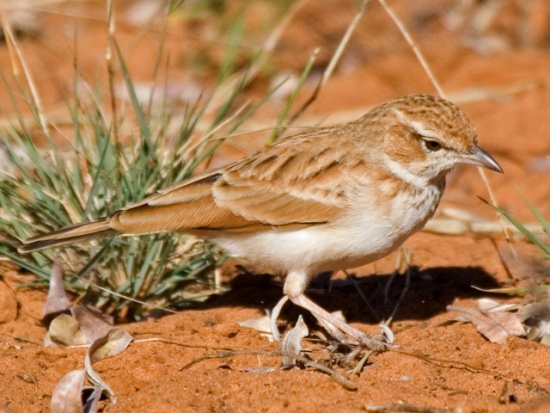- Calendulauda africanoides
Mirafra africanoides
Identification
Length 14-16 cm. A fairly small lark with relatively long wings and tail.
White underparts with lightly-streaked breast, plain face, and pale eyebrow. Upperparts vary in colour.
Similar species
- Sabota Lark is more heavily streaked (above and below) and has malar and moustachial stripes.
- Ferruginous Lark (Red Lark) is larger with a heavier bill and more clearly marked face; upperparts darker and redder.
Distribution
Southern Angola, south-eastern Zambia, Namibia, Botswana, Zimbabwe, southern Mozambique and northern South Africa.
Taxonomy
Formerly placed in genus Mirafra.
Subspecies
Six subspecies are recognized1:
- C. a. trapnelli:
- C. a. makarikari:
- C. a. harei:
- North-western and central Namibia
- C. a. sarwensis:
- Western Botswana
- C. a. africanoides:
- Southern Namibia, southern and eastern Botswana, western Zimbabwe and northern South Africa
- C. a. vincenti:
- Central Zimbabwe to southern Mozambique
Some authorities also recognize austinrobertsi2.
In the past3, Foxy Lark was included as additional subspecies.
Habitat
Savanna, shrubland and grassland on sandy soils (including dunes).
Behaviour
Usually found singly or in pairs on bare ground, but moves to the cover of vegetation if disturbed.
Diet
Forages for arthropods and seeds.
Breeding
Monogamous and territorial. The nest is a cup built of grass and rootlets on the ground; it usually has a grass dome. Two to four eggs are laid and incubated for about 12 days. Nestlings are fed by both parents and leave the nest after about 13 days.
References
- Clements, J. F., T. S. Schulenberg, M. J. Iliff, B.L. Sullivan, C. L. Wood, and D. Roberson. 2012. The eBird/Clements Checklist of Birds of the World. 6th ed., with updates to October 2012. Ithaca: Cornell Univ. Press. ISBN 978-0801445019. Spreadsheet available at http://www.birds.cornell.edu/clementschecklist/downloadable-clements-checklist
- Avibase
- Hockey, PAR, WRJ Dean, and PG Ryan, eds. 2005. Roberts' Birds of Southern Africa. 7th ed. Cape Town: John Voelcker Bird Book Fund. ISBN 978-0620340533
- Sibley, CG and BL Monroe. 1996. Birds of the World, on diskette, Windows version 2.0. Charles G. Sibley, Santa Rosa, CA, USA.
- Sinclair, I and P Ryan. 2003. Birds of Africa South of the Sahara. Princeton: Princeton Univ. Press. ISBN 978-0691118154
Recommended Citation
- BirdForum Opus contributors. (2024) Fawn-coloured Lark. In: BirdForum, the forum for wild birds and birding. Retrieved 9 November 2024 from https://www.birdforum.net/opus/Fawn-coloured_Lark




